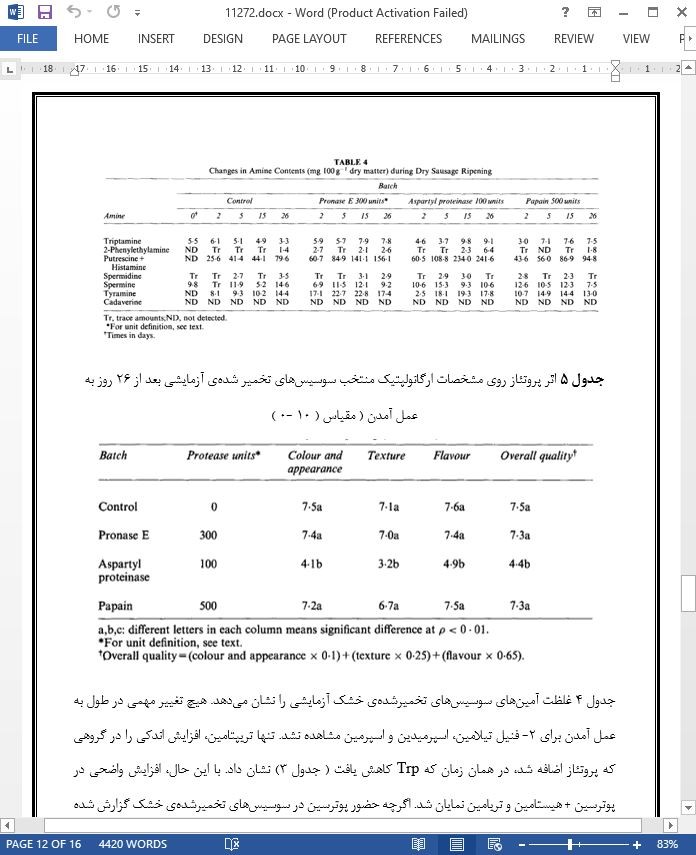
پروتئولیز در سوسیس های تخمیرشده خشک: اثر پروتئاز اگزوژن منتخب
چکیده
اثر سه پروتئاز تجاری (پروناز E از اﺳﺘﺮﭘﺘﻮﻣﺎﻳﺴﺲ ﮔﺮﻳﺰﺋﻮس، اسپارتيل پروتئاز از ﺁﺳﭙﺮﮊﻳﻠﻮﺱ ﺍﻭﺭﻳﺰﻩ و پاپایین ) روی تجزیه پروتئین و ویژگیهای حسی سوسیس تخمیرشده خشک مورد بررسی قرار گرفت. محلول آبی، غیر پروتئینی، محلول اسید فسفوتنگستیک 5%، محلول اسید سولفوسالیسیلیک 5% و حجم بازهای نیتروژنی فرّار در طول تخمیر افزایش یافت، پس از آن تا انتهای به عمل آمدن ثابت باقی ماند ( روز 26 ام). مقادیر نیتروژن همواره در گروهی که به آن اسپارتيل پروتئاز اضافه شد، در مقایسه با گروه هایی که سایر پروتئازها اضافه شدند بزرگتر بود. تغییرات کلی اسیدآمینه آزاد الگوی مشابهی را با تغییرات مشاهده شده در ازت محلول در اسید سولفوسالیسیلیک نشان داد. مطالعات الکتروفورتیک نشان داد که پروتئولیز میوفیبریلار با وزن مولکولی بالا و پروتئین های سارکوپلاسمی در گروه هایی که به آن ها پروتئاز اضافه شد برجسته تر است. این امر به ویژه در گروه پاپایین شدیدتر بود. اسیدهای آمینه ی غالب در انتهای به عمل آمدن در همه ی گروه ها مشابه بود. تریامین و هیستامین در هر قسمت از به عمل آمدن (کامل شدن) افزایش یافت. هیچ اختلاف معنی داری در ویژگی های حسی بین گروه های کنترل و گروههایی که به آن ها پروناز E و پاپایین اضافه شد یافت نشد، اما به دلیل نرم شدن مفرط، به شکل معنی داری متفاوت از سوسیس هایی بود که حاوی اسپارتيل پروتئاز بودند. اثر افزودن آنزیم اگزوژن روی تقویت طعم سوسیس تخمیر شده ی خشک مورد بحث است.
ویژگی های حسی
گروه هایی که به آن ها پاپایین و پروناز اضافه شد در تست مثلث تفاوتی با گروه کنترل نداشتند. با این حال،اختلاف معنی داری (p<0.01) ناشی از نرم شدن بیش از اندازه در گروهی که به آن آسپریل پروتئاز اضافه شد پیدا شد که با سه گروه دیگر مقایسه شد ( داده ها نشان داده نشده). جدول 5 اثر اضافه کردن سه آنزیم را روی برخی از ویژگی های حسی نشان می دهد. کیفیت کلی گروه های پروناز E و پاپایین در مقادیر نزدیک به مقادیر گروه کنترل ثبت شد.
گروه آسپریل پروتیناز نرم شدن قابل توجهی را نشان داد که به طور آشکار ناشی از پروتئولیز مفرط است. با این حال، اگرچه نمرات ظاهر و بافت توسط هیئت کارشناسی داوری شد و همچنان مشابه با گروه هایی با مقادیر بیشتری از این آنزیم ( 1992 (Diaz et al.بود، اما نتایج در ارزیابی طعم متفاوت بود. وقتی مقادیر بیشتری آسپریل پروتینئاز اضافه شد ( 1992 (Diaz et al. طعم بهتری بدست آمد که احتمالا ناشی از سطوح قسمت-های پروتئینی ای است که تشکیل شده.
Abstract
The effect of three commercial proteases (pronase E from Streptomyces griseus, aspartyl proteinase from Aspergillus oryzae and papain) on protein breakdown and the sensory characteristics of dry fermented sausages was investigated. Water soluble, non-protein, 5% phosphotungstic acid soluble, 5% sulphosalicylic acid soluble and total volatile basic nitrogen contents increased during fermentation, stabilizing later until the end of ripening (26th day). Nitrogen values were always greater in the aspartyl proteinase added batch in comparison with the other protease added batches. Total free amino acid changes showed a similar pattern to those observed for the 5% sulphosalicylic acid soluble nitrogen. The electrophoretic studies demonstrated that proteolysis of high molecular weight myofibrillar and sarcoplasmic proteins was more prominent in protease added batches. It was especially intensive in papain one. The dominant amino acids at the end of ripening were similar in all batches. Tyramine and histamine increased throughout ripening. No significant differences in sensory properties were found between control and pronase E and papain added batches, but they were significantly different (p < 0.01) from the sausages containing aspartyl proteinase, due to an excessive softening. The effect of exogenous enzyme addition on the flavour potentiation of dry fermented sausage is discussed.
Sensory properties
Pronase and papain-added batches did not differ from the control batch in the triangle test. Nevertheless, significant differences (p < 0.01) were found when the aspartyl proteinase-added batch was compared to the other three batches (data not shown), due to an excessive softening. Table 5 shows the effect of the addition of the three enzymes on some sensory characteristics. The overall quality of pronase E and papain batches were scored at values close to those of the control.
The aspartyl proteinase batch showed a remarkable softening, obviously due to excessive proteolysis. However, although appearance and texture scores were judged by the panel as similar to those of batches with higher amounts of this enzyme (Diaz et al., 1992) the results in flavour evaluation were different. When higher amounts of aspatyl proteinase were added (Diaz et al., 1992) a better flavour was obtained, probably due to the levels of protein fragments formed.
چکیده
مقدمه
مواد و روش ها
آماده سازی سوسیس و نمونه برداری
آنالیز میکروبی
آنالیز شیمیایی
آنالیز حسی
نتایج و بحث
فلور میکروبی
فعالیت آبی(aw) ، رطوبت و pH
بخش های نیتروژن دار
ویژگی های حسی
ABSTRACT
INTRODUCTION
MATERIALS AND METHODS
Sausage preparation and sampling
Microbial analyses
Chemical analyses
Sensory analysis
RESULTS AND DISCUSION
Microbial flora
Water activity (aw), moisture and pH
Nitrogen fractions
Sensory properties
- اصل مقاله انگلیسی با فرمت ورد (word) با قابلیت ویرایش
- ترجمه فارسی مقاله با فرمت ورد (word) با قابلیت ویرایش، بدون آرم سایت ای ترجمه
- ترجمه فارسی مقاله با فرمت pdf، بدون آرم سایت ای ترجمه



